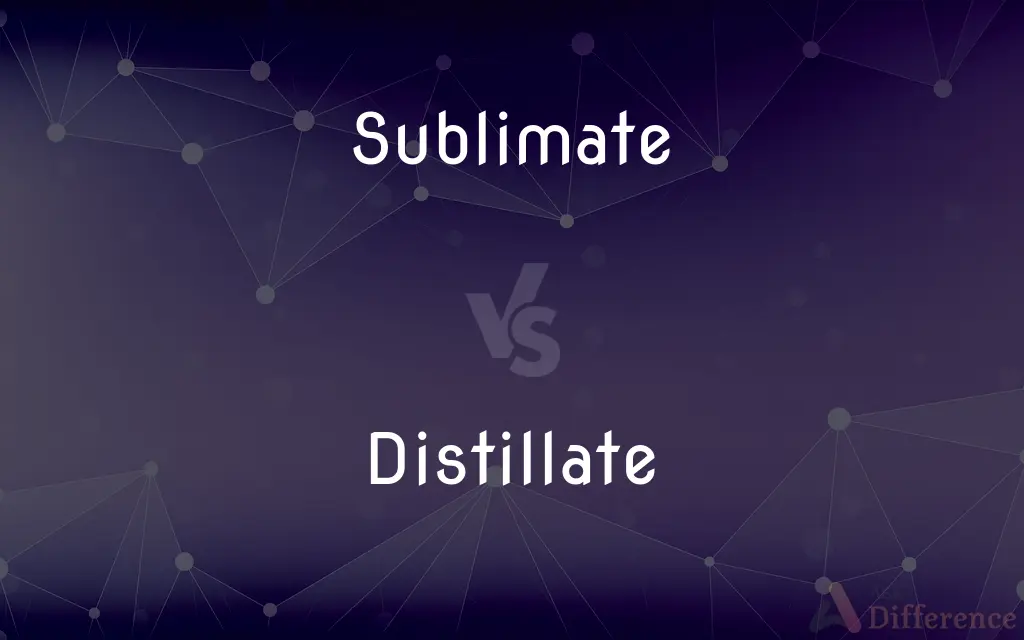Sublimate vs. Distillate — What's the Difference?
By Urooj Arif & Maham Liaqat — Updated on March 11, 2024
Sublimation is the process of a substance transitioning directly from solid to gas without becoming liquid, while distillation involves vaporizing a liquid and then condensing it back into a liquid.

Difference Between Sublimate and Distillate
Table of Contents
ADVERTISEMENT
Key Differences
Sublimation is a phase transition where a solid turns directly into a gas upon heating, bypassing the liquid stage. This process is used in various scientific and industrial applications, such as in the manufacture of freeze-dried foods and the purification of substances. On the other hand, distillation is a technique for separating mixtures based on differences in their boiling points. It involves heating a liquid to create vapor, which is then cooled and condensed back into a liquid. This method is widely used in the production of spirits, the purification of water, and the separation of chemical substances.
The conditions under which sublimation occurs are specific to the substance's pressure and temperature characteristics. For example, dry ice (solid CO2) sublimates at atmospheric pressure at temperatures below -78.5°C. Distillation, however, can occur at various temperatures, depending on the boiling points of the components in the mixture being separated. The efficiency and effectiveness of distillation are often enhanced by using techniques like fractional distillation, which allows for the separation of substances with very close boiling points.
Sublimation requires a substance that can transition from a solid to a gas without passing through a liquid phase under specific conditions. This characteristic is not common to all substances and limits the application of sublimation to certain materials. Distillation is more universally applicable to mixtures of liquids and can be used to separate or purify a wide range of substances, including those that do not sublimate.
The equipment used in sublimation and distillation also differs significantly due to the nature of the processes. Sublimation setups often involve a simple apparatus where the solid is heated under controlled conditions to cause sublimation. The gas is then collected directly or allowed to deposit as a pure solid. Distillation apparatus, such as simple and fractional distillation setups, includes a heating source, distillation column, condenser, and collection vessels, designed to efficiently vaporize, separate, and condense the liquid components.
In terms of applications, sublimation is widely used in the preparation of certain pharmaceuticals, the printing industry (sublimation printing), and in the purification of small quantities of compound. Distillation has a broader range of applications, including the separation of petroleum into fractions, the production of alcoholic beverages, and the purification of chemicals and water for various industrial, laboratory, and consumption purposes.
ADVERTISEMENT
Comparison Chart
Phase Transition
Solid to gas without becoming liquid.
Liquid to vapor then back to liquid.
Common Uses
Freeze-drying, purification of substances.
Producing spirits, water purification.
Conditions
Specific pressure and temperature.
Based on boiling points of components.
Substance Requirement
Only for substances that can bypass liquid phase.
Applicable to mixtures of liquids.
Equipment
Simple heating and collection setup.
Heating source, distillation column, condenser.
Applications
Pharmaceuticals, printing industry.
Petroleum separation, alcoholic beverages.
Compare with Definitions
Sublimate
Transition from solid to gas without becoming liquid.
Dry ice sublimates at room temperature, directly turning into carbon dioxide gas.
Distillate
Product of distillation, liquid from vapor.
The distillate from crude oil processing includes gasoline.
Sublimate
Pharmaceutical preparation.
Some medicines are prepared through sublimation to ensure purity.
Distillate
Used in producing spirits.
Whiskey is a distillate obtained from fermented grain mash.
Sublimate
Used in freeze-drying foods.
Sublimation helps preserve the structure and nutrition of freeze-dried fruits.
Distillate
Essential oil extraction.
Lavender oil is obtained as a distillate through the steam distillation of lavender flowers.
Sublimate
In printing technology.
Sublimate printing transfers images to fabrics using gas-phase ink.
Distillate
Separation of chemical substances.
Distillate fractions are collected based on boiling points in chemical synthesis.
Sublimate
Purification process.
Sublimation purifies naphthalene by transitioning it from solid to gas.
Distillate
Water purification method.
Distillation removes impurities, yielding pure water as distillate.
Sublimate
(in psychoanalytic theory) divert or modify (an instinctual impulse) into a culturally higher or socially more acceptable activity
Libido must be sublimated into productive work activities
Distillate
A liquid condensed from vapor in distillation.
Sublimate
Another term for sublime
Distillate
A purified form; an essence
"Dos Passos, a distillate of native American idealism and Yankee common sense" (William F. Buckley).
Sublimate
A solid deposit of a substance which has sublimed
Condensation of a sublimate
Distillate
The liquid that has been condensed from vapour during distillation; normally a purified form or a fraction of an original liquid.
Sublimate
To be transformed directly from the solid to the gaseous state or from the gaseous to the solid state without becoming a liquid.
Distillate
(by extension) The essence of something.
Sublimate
(Chemistry) To cause (a solid or gas) to sublimate.
Distillate
(AU) Diesel fuel.
Sublimate
(Psychology) In psychoanalytic theory, to divert or modify (an instinctual impulse or drive) into an activity or interest of higher social value.
Distillate
The product of distillation; as, the distillate from molasses.
Sublimate
(Chemistry) A product of sublimation.
Distillate
A purified liquid produced by condensation from a vapor during distilling; the product of distilling
Sublimate
To change state from a solid to a gas without passing through the liquid state.
Sublimate
To purify or refine a substance through such a change of state.
Sublimate
(archaic) To raise to a place of honor; to refine and exalt.
Sublimate
(chemistry) A product obtained by sublimation.
Sublimate
To bring by heat into the state of vapor, which, on cooling, returns again to the solid state; as, to sublimate sulphur or camphor.
Sublimate
To refine and exalt; to heighten; to elevate.
The precepts of Christianity are . . . so apt to cleanse and sublimate the more gross and corrupt.
Sublimate
A product obtained by sublimation; hence, also, a purified product so obtained.
Sublimate
Brought into a state of vapor by heat, and again condensed as a solid.
Sublimate
The product of vaporization of a solid
Sublimate
Direct energy or urges into useful activities
Sublimate
Make more subtle or refined
Sublimate
Remove impurities from, increase the concentration of, and separate through the process of distillation;
Purify the water
Sublimate
Change or cause to change directly from a solid into a vapor without first melting;
Sublime iodine
Some salts sublime when heated
Sublimate
Vaporize and then condense right back again
Sublimate
Made pure
Common Curiosities
How does sublimation differ from distillation?
Sublimation involves a direct solid-to-gas phase change, bypassing liquid, while distillation involves liquid vaporizing into gas, then condensing back to liquid.
What is sublimation?
Sublimation is the process where a solid turns directly into a gas without passing through the liquid phase, under specific conditions.
What is distillation?
Distillation is a method of separating mixtures based on differences in boiling points, involving vaporization of a liquid and subsequent condensation back into liquid.
Can all substances sublimate?
No, only certain substances can sublimate under specific conditions; not all solids can bypass the liquid phase.
Can distillation separate any mixture?
Distillation is effective for mixtures with components that have significantly different boiling points; it is less effective for substances with very similar boiling points, without using specialized techniques like fractional distillation.
What are the main applications of distillation?
Distillation is used for the separation and purification of liquids, such as in the production of spirits, water purification, and chemical processing.
Can distillation improve the taste of water?
Yes, distillation can remove impurities and minerals from water, often improving taste by producing water that is nearly pure H2O.
Is distillation used only for liquid mixtures?
Primarily, yes, distillation is used to separate mixtures of liquids, though it can also purify solids by first dissolving them in a liquid solvent.
What equipment is needed for sublimation?
Sublimation typically requires a heating device and a surface for the gas to deposit if collecting the purified substance is desired.
What is the primary advantage of sublimation?
The primary advantage of sublimation is its ability to purify substances without involving a liquid phase, which can be particularly useful for materials that degrade or decompose upon melting.
How is distillate collected?
Distillate is collected after the vapor cools and condenses back into a liquid form, typically in a separate vessel or part of the distillation apparatus designed for collection.
Why is sublimation not more widely used?
Sublimation is limited to substances that can transition directly from solid to gas, which narrows its applicability compared to more universally applicable methods like distillation.
What substances commonly undergo sublimation?
Substances like dry ice (solid CO2), iodine, naphthalene, and certain metal acetylacetonates are known to readily sublimate under appropriate conditions.
How does pressure affect sublimation?
Pressure significantly affects sublimation; reducing the pressure can lower the temperature at which sublimation occurs, making it easier for some substances to sublimate.
What safety precautions are necessary for distillation?
Safety precautions for distillation include proper ventilation, monitoring of temperature and pressure, and the use of heat-resistant and chemical-resistant materials to prevent accidents.
What are the environmental impacts of distillation?
The environmental impacts of distillation include energy consumption and potential emissions from heating sources, though modern systems aim to minimize these effects through efficiency improvements and cleaner energy sources.
Is distillation energy-intensive?
Distillation can be energy-intensive, especially for large-scale operations or when separating substances with very close boiling points, as it requires significant heating and cooling.
Share Your Discovery

Previous Comparison
Pleb vs. Plebe
Next Comparison
Mission vs. QuestAuthor Spotlight
Written by
Urooj ArifUrooj is a skilled content writer at Ask Difference, known for her exceptional ability to simplify complex topics into engaging and informative content. With a passion for research and a flair for clear, concise writing, she consistently delivers articles that resonate with our diverse audience.
Co-written by
Maham Liaqat















































